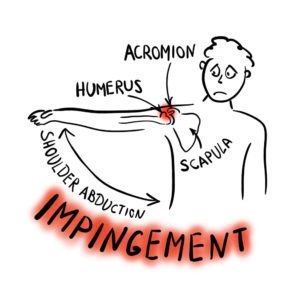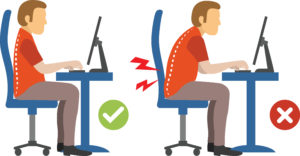Shoulder Impingement Syndrome
Shoulder impingement syndrome is a frequent cause of shoulder pain. Shoulder impingement occurs in the shoulder when the tendons or bursa become impeded from the bones.
The use of the shoulder during overhead activity is a significant risk factor. Some examples of this kind of activity can include painting, lifting, swimming, tennis, or any other overhead sports. Additional risk factors may consist of bone and joint abnormalities.
Unfortunately, pain can become persistent and affect everyday life. Specific ranges of motion may become limited, and can often cause pain.
Over time, impingement syndrome can lead to tendinitis and bursitis. Inflammation of the rotator cuff is also common, and, if left untreated, rotator cuff tendons can start to wear away.
What Are The Symptoms?
Typical symptoms may include difficulty reaching behind the back and neck, or pain with overhead use of the arm.
If tendons become injured for long periods, they can tear apart, resulting in a rotator cuff tear. This condition may cause significant weakness and may make it difficult to elevate the arm.
How Is Shoulder Impingement Syndrome Diagnosed?
All diagnoses should begin with a medical exam from your doctor. X-rays may be taken to rule out arthritis. Bone spurs and other ailments may also become apparent.
How Is Shoulder Impingement Syndrome Treated?
Anti-inflammatory medications (like aspirin, naproxen, or ibuprofen) are the most common treatments. These medicines are usually taken for six to eight weeks to treat the problem adequately. However, it is always recommended to see a doctor so you can get the best treatment for your individual case. A chiropractic doctor will provide non-surgical treatment with exercises and rehabilitative care.
What Causes Shoulder Impingement?
Numerous factors have been determined. They include:
- Shoulder movements associated with rotator cuff breakdown
- Bad posture
- Repetitive shoulder movements, specifically overhead athletic activity
- Injury
- Bony abnormalities
- Osteoarthritis
- Poor muscle strength
- Thickening of the bursa and shoulder ligaments
How Do You Know If You Have Shoulder Impingement?
Here are instructions for a shoulder impingement self-test:
- Take your hand (on the painful side) and place it on your opposite shoulder (the shoulder without any pain). Your elbow should be bent and resting across your chest
- Try to lift your elbow toward your face.
- If this causes you pain, it means that shoulder impingement is the most likely reason.
What To Do?
- Start with icing (reduces inflammation)
- Self-massage to alleviate immediate pain
- See your doctor
For help and more information, please contact Charschan Chiropractic and Sports Injury Consultants. We provide non-surgical manipulation of the shoulder and surrounding areas to treat effectively. Our treatment plan includes the necessary treatment technique along with the required stretches, exercises and active rehabilitative care.
To better serve you, we have two convenient locations: North Brunswick, NJ, and Scotch Plains, NJ.